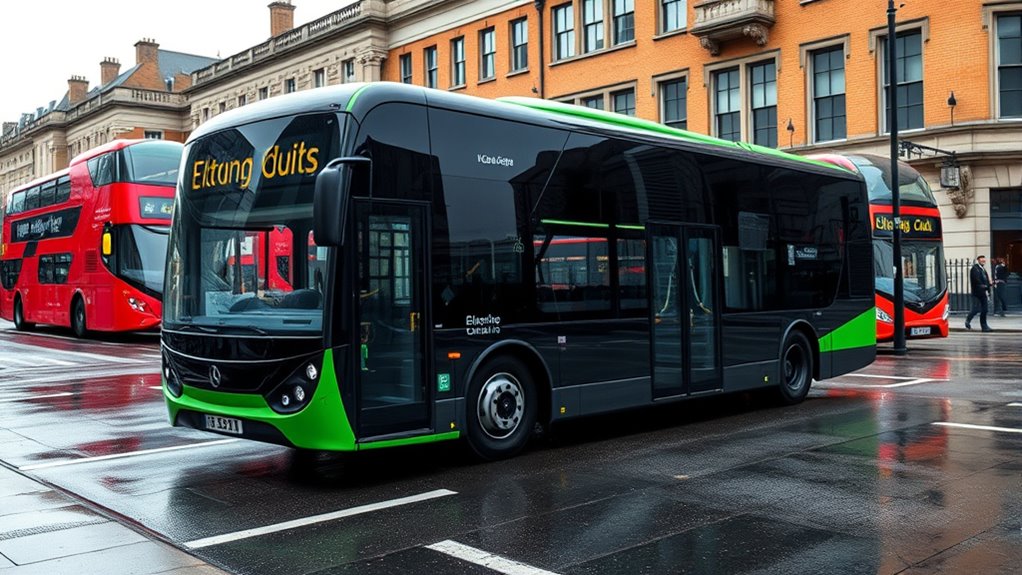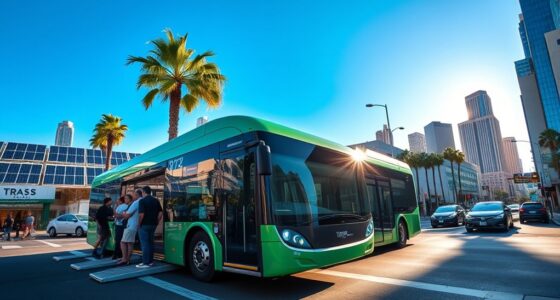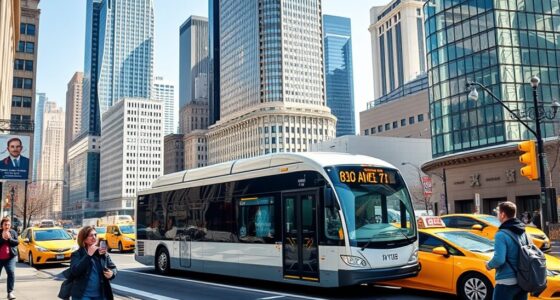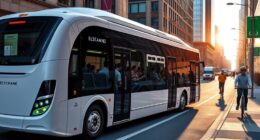London’s electric bus fleet cuts emissions by replacing diesel-powered buses with zero-emission models, powered by advanced battery technologies and rapid charging infrastructure. These buses eliminate exhaust pollutants, improving air quality and public health. Innovative features like regenerative braking and IoT monitoring optimize performance and efficiency. Strong policies and investments support widespread adoption, helping London meet its climate goals. To discover how these initiatives are transforming urban transport further, stay tuned for more insights.
Key Takeaways
- Electric buses eliminate exhaust emissions, significantly reducing pollutants like particulate matter and nitrogen oxides.
- Transitioning to zero-emission buses supports London’s goal of achieving net-zero carbon emissions by 2030.
- Advanced battery and regenerative braking technologies enhance efficiency and extend operational range, decreasing energy consumption.
- Infrastructure upgrades, including renewable energy-powered charging stations, minimize the carbon footprint of bus operations.
- Full fleet electrification prevents millions of tonnes of CO2 emissions annually, improving urban air quality and public health.
The Evolution of London’s Zero-Emission Bus Strategy
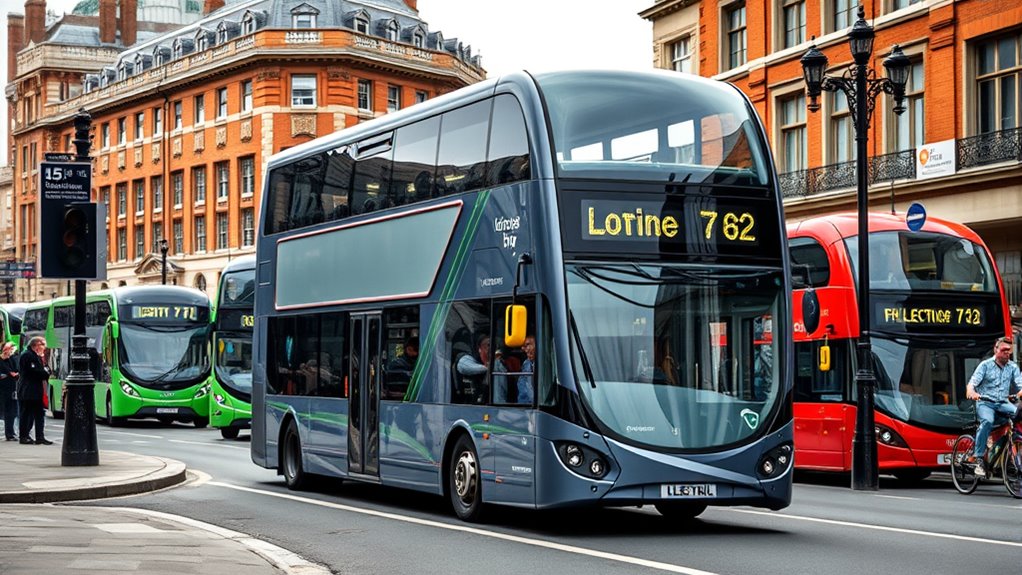
London’s zero-emission bus strategy has evolved rapidly to meet its ambitious climate goals. The initial target was to make the entire fleet zero-emission by 2037, but this was brought forward to 2034, showing increased commitment to sustainability. With additional government funding, the timeline could shift even earlier to 2030, aligning with London’s broader plan to become a net-zero city by 2030. Achieving these targets requires collaboration among government agencies, transport authorities, and private companies. This concerted effort pushes London toward a cleaner, greener future, emphasizing the importance of rapid electrification. The strategy reflects a clear dedication to reducing emissions and improving air quality, setting an example for other cities aiming for similar environmental milestones. Electrification technology continues to advance, making the transition more feasible and efficient. Embracing innovative battery storage solutions is also crucial for maintaining reliable service and managing energy demands during peak times. Additionally, ongoing research into charging infrastructure plays a vital role in supporting the widespread adoption of electric buses, with innovations in smart grid integration helping optimize energy use and reduce costs.
Cutting-Edge Technologies Powering the Fleet

Cutting-edge technologies are at the heart of London’s electric bus fleet, driving efficiency, reliability, and sustainability. High-capacity lithium-ion batteries give you extended range and support all-day service, while regenerative braking recovers energy during deceleration, boosting efficiency by up to 20%. Vetted solutions ensure safety and performance standards are met across the fleet. Overnight charging stations ensure buses are ready each morning without disrupting operations. Thermal management systems protect batteries from overheating, prolonging their lifespan. Modular battery designs let you tailor energy capacity to route demands. Rapid Siemens chargers minimize downtime on high-frequency routes, and IoT hardware monitors energy use in real time, optimizing load distribution. Smart grid integration and scalable networks support the fleet’s growth, guaranteeing the technology keeps pace with London’s ambitious emissions reduction goals. Additionally, ongoing research into battery longevity helps improve the durability and cost-effectiveness of the fleet’s energy storage solutions. Incorporating performance tuning strategies can further enhance the efficiency and lifespan of electric vehicle components, aligning with sustainability objectives.
Infrastructure Innovations Supporting Electric Buses

How do infrastructure upgrades enable the seamless operation of electric buses across the city? Upgrades like thorough depot retrofits provide charging stations, maintenance facilities, and grid connections tailored for electric fleets. These enhancements guarantee buses are charged efficiently, with scalable power systems that prevent service disruptions. Implementing advanced power management systems ensures optimal energy distribution and reduces operational costs. High-speed pantograph chargers on routes like the 358 allow rapid top-ups, reducing downtime. Smart energy management and demand-response systems balance grid loads, while on-site substations handle peak demands. Additionally, collaborations with utility providers ensure a stable, sustainable energy supply, which is essential for maintaining consistent service levels. Investing in smart grid technology further enhances the capacity to manage increased electricity demands effectively. Moreover, the integration of renewable energy sources can significantly decrease the carbon footprint of the electric bus fleet. These innovations create a reliable, flexible infrastructure that supports London’s goal of a fully electric bus fleet, making daily operations smoother and more efficient.
Environmental Benefits and Air Quality Improvements
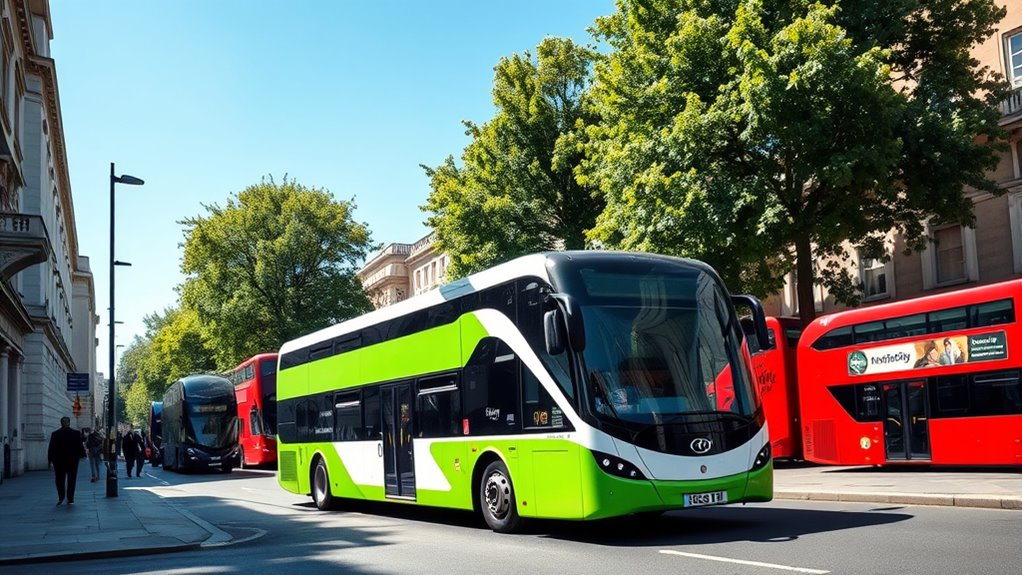
Upgrading infrastructure to support electric buses not only improves operational efficiency but also delivers significant environmental benefits. You’ll notice cleaner air as electric buses eliminate exhaust emissions, helping London meet its goal of a fully zero-emission fleet by 2034.
These buses markedly reduce harmful pollutants like particulate matter and nitrogen oxides, which directly improves urban air quality. As a result, public health benefits grow, with fewer respiratory and cardiovascular diseases linked to pollution. Additionally, the adoption of electric buses encourages the use of advanced battery technology, further enhancing their range and performance.
Shifting to electric vehicles also cuts greenhouse gas emissions, supporting the city’s climate targets. The integration of electric bus charging infrastructure plays a crucial role in maintaining operational consistency and efficiency. Implementing renewable energy sources for charging stations can further reduce the environmental impact of the fleet. With over 1,700 zero-emission buses already in operation, London is making steady progress toward sustainable transport.
Implementing Gold IRA strategies can further support the city’s financial resilience and long-term sustainability efforts. This change not only reduces the city’s carbon footprint but also fosters a healthier, cleaner environment for everyone.
Partnerships Fueling the Transition to Clean Transit
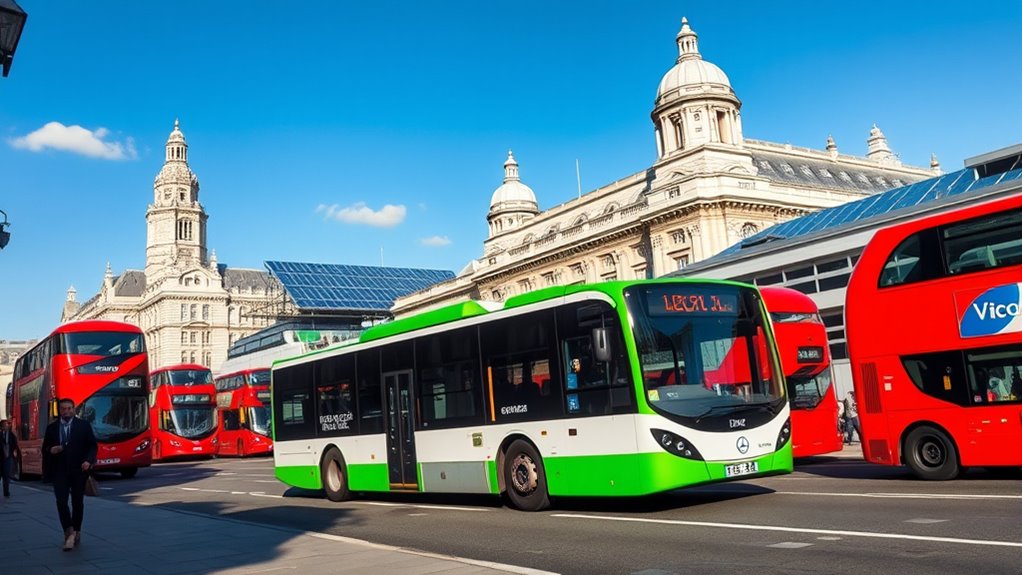
Partnerships play a crucial role in accelerating London’s shift to a fully electric bus fleet. You benefit from collaborations between major players like Siemens, BYD, and Alexander Dennis, which have helped deliver nearly 300 electric buses to Go-Ahead London.
These partnerships also support infrastructure development, with Siemens Financial Services backing charging stations across the city. Technological innovations, driven by joint efforts, lead to more efficient, environmentally friendly bus designs and improved battery technology, extending range and performance. Sustainable transportation initiatives are further enhanced by shared expertise and resources among these organizations. Additionally, these collaborations foster innovative solutions that address unique challenges in urban mobility. Strong public-private partnerships are essential for securing funding and scaling sustainable transit initiatives effectively.
Funding from the government and financial institutions accelerates deployment, enabling London to reach milestones like the 1,500th electric bus. Additionally, ongoing research and development efforts are vital for advancing electric vehicle technology, ensuring the city’s transit system remains at the forefront of sustainable mobility. As a result, routes are electrified, depots converted, and public awareness increased, all fueling the city’s transition toward sustainable, zero-emission transportation.
Policy Drivers Accelerating Electric Bus Adoption

Policy frameworks and government incentives are propelling London’s push toward electric buses at an unprecedented pace. The Mayor’s Transport Strategy aims for 80% of trips by foot, bike, or public transport by 2041, with a clear focus on achieving net-zero carbon emissions by 2030. The goal is to have the entire bus fleet zero-emission by 2034. Since 2019, all new double-deck buses are at least hybrid, and from 2020, single-deck buses emit zero exhaust emissions. Regulatory incentives, like stricter emissions standards and funding support, encourage operators to shift to electric fleets. These policies are complemented by urban air quality concerns and technological advancements, such as rapid charging and improved batteries, which accelerate adoption. AI technologies data analysis can optimize route planning and energy consumption, further supporting sustainable transit initiatives. Additionally, the integration of advanced battery technology enhances the range and efficiency of electric buses, making widespread adoption more feasible. The development of renewable energy sources for charging stations also plays a crucial role in reducing overall emissions, supporting London’s ambitious environmental goals. Furthermore, the emergence of smart grid systems enables more efficient energy distribution, ensuring that charging infrastructure aligns with renewable generation. Together, they create a robust framework driving London’s sustainable transport future.
Operational Successes and Challenges in Electrification
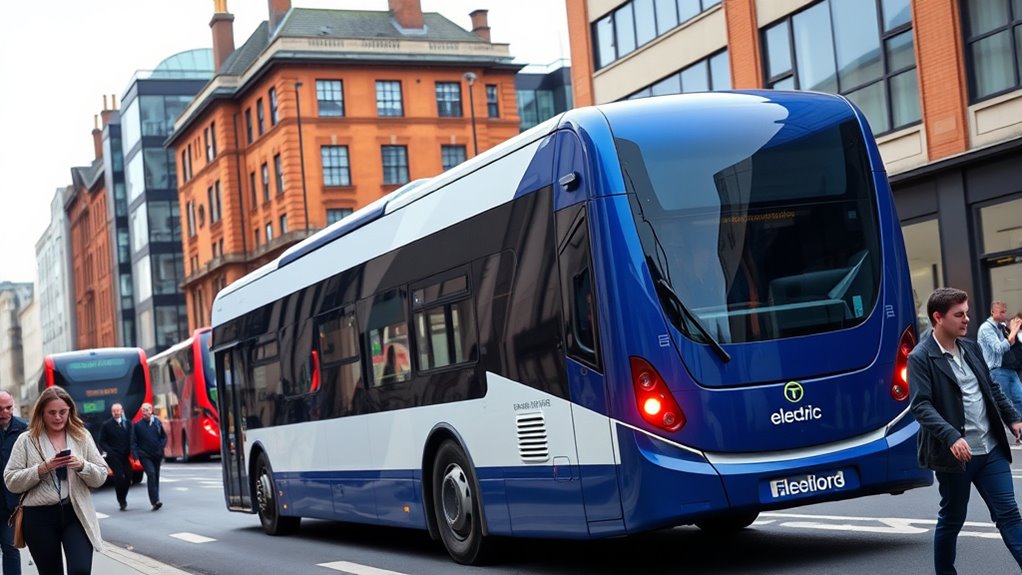
London has achieved significant milestones in electrifying its bus network, demonstrating both operational success and ongoing challenges. By 2021, Route 63 fully converted to electric buses, and today, over 1,600 zero-emission buses operate across the city, making London’s fleet the largest in Western Europe.
These advances lead to substantial emission reductions, with full fleet electrification potentially saving up to 5.5 million tonnes of carbon by 2030. However, challenges persist. High infrastructure costs, including depot upgrades and charging stations, require significant investment.
Managing charging times within busy schedules and scaling up the fleet remain hurdles. Despite these issues, London continues to push forward, leveraging technological innovations and strategic partnerships to optimize operations while working toward a cleaner, greener transit future.
The Future Impact of London’s Electric Bus Initiatives

The ongoing expansion of electric buses is set to dramatically improve urban air quality and reduce greenhouse gas emissions, shaping a cleaner future for cities worldwide.
As London aims to have its entire fleet electrified by 2030, you’ll see even greater reductions in toxic pollution and carbon footprints. This shift aligns with the city’s goal of reaching net-zero emissions, positioning London as a global leader in sustainable transportation.
The increased number of electric buses and investments in charging infrastructure will support smoother, more efficient operations. These efforts not only benefit public health and quality of life but also set a powerful example for other cities to follow.
With continued innovation and collaboration, electric buses will play a crucial role in combating climate change and transforming urban mobility.
Frequently Asked Questions
How Does the Pantograph Charging System Work During Daily Operations?
You operate the pantograph charging system during daily runs by extending the inverted pantograph from the gantry to connect with the bus’s roof receptor. Once connected, high-power DC charges flow quickly, often in just three to six minutes, recharging the bus efficiently.
The automated system manages the process, reducing downtime, and allows for seamless in-route or overnight charging, keeping your fleet ready while minimizing emissions.
What Are the Cost Savings Associated With Electric Buses Compared to Diesel?
You’ll find that electric buses save you money through lower fuel costs—about 2.5 times cheaper than diesel—and reduced maintenance expenses due to fewer moving parts.
Although their initial price is higher, incentives and funding offset these costs.
Over their lifetime, electric buses can save you between $73,000 and $173,000, thanks to energy efficiency, longer durability, and stable electricity prices, making them a smart long-term investment.
How Does London’s Electric Fleet Impact Local Air Quality Long-Term?
Imagine a cleaner London, where the air feels fresher and healthier. Your city’s electric bus fleet markedly improves long-term air quality by eliminating tailpipe emissions and reducing harmful pollutants like NOx and PM2.5.
This means fewer respiratory issues and better health for everyone, especially in dense neighborhoods. As the fleet expands, these benefits grow, creating a sustainable, breathable city where future generations can thrive, not just survive.
What Challenges Are Faced in Retrofitting Existing Depots for EVS?
You face several challenges when retrofitting depots for EVs. You need to reinforce structures for charging stations, expand the grid to handle increased power demand, and find space-efficient solutions in crowded depots.
High upfront costs and securing funding complicate upgrades. Operational disruptions can occur during renovations, and staff must learn new maintenance procedures.
Additionally, compatibility issues between charging hardware and buses can slow progress.
How Does Passenger Feedback Influence the Electric Bus Transition?
Passenger feedback acts as the wind in the sails of London’s electric bus changeover, steering improvements and support. When riders share positive experiences, it boosts confidence in the new technology and encourages further investment.
Your input helps identify issues like charging efficiency or service reliability. This feedback creates a feedback loop, ensuring the transition meets public expectations, making the shift not just a goal but a shared journey toward cleaner air and sustainable travel.
Conclusion
So, congratulations! London’s electric bus fleet is practically saving the planet one silent, zero-emission ride at a time. Who knew that replacing noisy, polluting buses with sleek electric ones would turn the city into a gust of fresh air? Maybe soon, you’ll be able to enjoy a commute so clean, even your grandma’s inhaler will thank you. Keep riding, keep laughing—London’s green revolution is just getting started!
